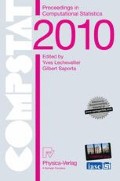Abstract
Classification methods have proven effective for predicting the creditworthiness of credit applications. However, the tendency of the underlying populations to change over time, population drift, is a fundamental problem for such classifiers. The problem manifests as decreasing performance as the classifier ages and is typically handled by periodic classifier reconstruction. To maintain performance between rebuilds, we propose an adaptive and incremental linear classification rule that is updated on the arrival of new labeled data. We consider adapting this method to suit credit application classification and demonstrate, with real loan data, that the method outperforms static and periodically rebuilt linear classifiers.
Access this chapter
Tax calculation will be finalised at checkout
Purchases are for personal use only
Preview
Unable to display preview. Download preview PDF.
References
ADAMS, N.M. and HAND, D.J. (1999): Comparing classifiers when the misallocation costs are uncertain. Pattern Recognition 32, 1139–1147.
ANAGNOSTOPOULOS, C., TASOULIS D.K., ADAMS, N.M., PAVLIDIS, N. G. and D.J. HAND, D.J. (2009): Streaming aussian classification using recursive maximum likelihood with adaptive forgetting Machine Learning, under review.
HAND, D.J. (2001): Reject inference in credit operations. In: E. Mays (Eds.): Handbook of Credit Scoring, Glenlake Publishing, Chicago, 225–240.
HAND, D.J. (2005): Good practice in retail credit scorecard assessment. Journal of the Operational Research Society 56, 1109–1117.
HAND, D.J. (2009): Measuring classifier performance: a coherent alternative to the area under the ROC curve. Machine Learning 77, 103–123.
HAND, D.J. and HENLEY, W.E. (1997): Statistical classification methods in consumer credit scoring: a review. Journal of the Royal Statistical Society Series A, Statistics in Society 160(3), 523–541.
HAYKIN, S. (2001): Adaptive Filter Theory, 4th edn. Prentice Hall.
KELLY, M. G., HAND, D.J. and ADAMS, N.M. (1999): The impact of changing populations on classifier performance. In: S.Chaudhuri and D. Madigan (Eds.), Proceedings of the Fifth ACM SIGKDD International Conference on Knowledge Discovery and Data Mining, Association for Computing Machinery, New York, 367–371.
LUCAS, A. (1992): Updating scorecards: removing the mystique. In: L. Thomas, J. Crook, and D. Edelman (Eds.), Credit Scoring and Credit Control, Clarendon: Oxford, 180–197.
SIDDIQI, N. (2006): Credit Risk Scorecards: developing and implementing intelligent credit scoring. Wiley.
WEBB, A. (2002): Statistical Pattern Recognition, 2nd edn. Wiley.
Acknowledgments
This work was supported by the ALADDIN project and is jointly funded by a BAE Systems and EPSRC (Engineering and Physical Research Council) strategic partnership, under EPSRC grant EP/C548051/1. We are grateful to the UK bank that provided the data. The work of David Hand was supported by a Royal Society Wolfson Research Merit Award.
Author information
Authors and Affiliations
Corresponding author
Editor information
Editors and Affiliations
Rights and permissions
Copyright information
© 2010 Springer-Verlag Berlin Heidelberg
About this paper
Cite this paper
Adams, N.M., Tasoulis, D.K., Anagnostopoulos, C., Hand, D.J. (2010). Temporally-Adaptive Linear Classification for Handling Population Drift in Credit Scoring. In: Lechevallier, Y., Saporta, G. (eds) Proceedings of COMPSTAT'2010. Physica-Verlag HD. https://doi.org/10.1007/978-3-7908-2604-3_15
Download citation
DOI: https://doi.org/10.1007/978-3-7908-2604-3_15
Published:
Publisher Name: Physica-Verlag HD
Print ISBN: 978-3-7908-2603-6
Online ISBN: 978-3-7908-2604-3
eBook Packages: Mathematics and StatisticsMathematics and Statistics (R0)

